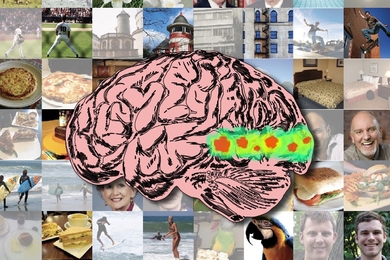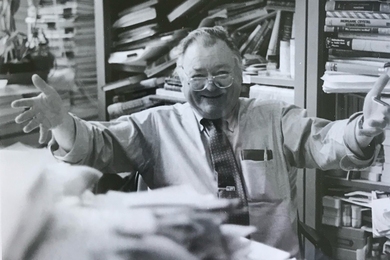About 250 people gathered last Friday for a day-long celebration of Building 20, the shabby but beloved "temporary" home to a myriad of people and pursuits, and the incubator for research that led to atomic clocks and much more.
The building, constructed in 1943 and expected to last "for the duration of [World War II] and six months thereafter" according to a letter from the original contractor, will be razed this summer. It will be replaced by a new center for computing, information science, artificial intelligence, and linguistics and philosophy.
If Building 20 "was an ordinary building, there'd be no need for a gathering like this. But as we know, it's not ordinary," said Professor Paul L. Penfield, head of the Department of Electrical Engineering and Computer Science (EECS) and chair of the Building 20 Commemoration Committee. "It had an uncanny, magical power to bring out the best in everybody."
What made the building so special? Several speakers stressed the coexistence of people in a variety of disciplines, "from ROTC to [Institute Professor and linguist Noam] Chomsky," as Provost Joel Moses put it.
The building also "induced people to communicate with one another," said Peter Elias, professor of electrical engineering, emeritus. How? For one, the doors. Walter E. Morrow, director of MIT Lincoln Laboratory and a professor in EECS, explained that there wasn't much room in the laboratories, so people pulled the doors open and pinned them back with various pieces of equipment.
The result: "as you wandered down the corridors, you saw what was going on in the rooms," Professor Morrow said. "In that process, you learned of many wondrous things in addition to your own work."
HOLES IN THE WALLS
The "temporary" nature of Building 20 was also conducive to research. Its residents could knock holes in the walls and otherwise adapt the building to their needs. "It was a place that would be shaped by its occupants," said Jerome V. Lettvin, professor of electrical engineering and bioengineering, emeritus. "It was not something to be imposed on them; it was what you'd call a malleable space."
Professor Morrow recalled a time when a hole was punched in the roof (unintentionally). The incident involved an antenna that a research team wanted to tether to the roof. "But there was no place to fasten it to, so they borrowed some lead bricks from the nuclear people." This worked well until a wind storm blew the antenna to one side, lifting a brick. When the brick came down it crashed through the roof, ultimately smashing the experiment in the room below. (The experiment was eventually fixed, and the student went on to complete his thesis.)
Institute Professor Emeritus Morris Halle noted that the abundance of space in Building 20 meant that "many quite risky projects got off the ground. Linguistics, my field, was one such risky project. But for the existence of Building 20, it would not have been developed at MIT."
FIVE-DOT SPEAKERS
Professor Halle was one of at least three "five-dot" speakers. During registration for the celebration, participants affixed color-coded dots to their name tags representing the decade(s) they lived in Building 20. Other five-dot speakers were Professor Lettvin and Professor Rainer Weiss of Physics.
The abundance of space in Building 20 also helped realize the dreams of an MIT freshman interested in solar cars. James Worden (SB '89), co-founder and CEO of Solectria Corp., recalled meeting Doc Edgerton, who learned of his interest in solar vehicles and promptly offered him space in the building. Later, building residents became familiar with the sight of Mr. Worden driving one of his vehicles through the corridors to get it to his lab.
Another key theme of the celebration was the research that was based in the building. Ted Saad (SB '41) shared his memories of the laboratory that Building 20 was built to house: the Radiation Laboratory. Dr. Saad was an original member of the RadLab, which was organized to further develop radar during World War II.
"We were committed to anything and everything needed to make microwaves work," he said. Their efforts resulted, among other things, in microwave radar that enabled one aircraft to detect another and a system that directed the aim of ground-based guns to shoot down enemy aircraft.
The RadLab was terminated in 1945. Its general concept for research, however, continued with the formation of the Research Laboratory of Electronics, also housed in Building 20. Lincoln Laboratory and the Laboratory for Nuclear Science also began in Building 20.
Professor Weiss described several research projects begun in Building 20 that later led to applications in use today. These include the Collins Cryostat, a device that made liquid helium that led to magnetic resonance imaging used in hospitals, and precision-measurement devices for looking at atoms that are the predecessors for today's atomic clocks.
Work begun in Building 20 in 1972 could also result in the detection of gravity waves from phenomena like supernovae and black holes. This "will test Einstein on a level we haven't seen before," said Professor Weiss. "We will know within the next four to five years if Building 20 is again honored, this time by the discovery of gravity waves."
Other speakers at the celebration were Assistant Professor Gill Pratt of EECS; Professor Robert P. Redwine of physics, director of the Laboratory for Nuclear Science; and Alan Kotok (SB '62), associate chairman of the World Wide Web Consortium. Mr. Kotok talked about the Tech Model Railroad Club, yet another group that was housed in Building 20.
The day's festivities included tours of Building 20 and of the new facilities for the railroad club. Friday evening featured a reception and dinner in honor of Maria and Ray Stata (SB '57), who donated $25 million for the complex of buildings that will replace Building 20.
Reminiscences of life inside Building 20 can be found at EECS and RLE web sites.
A version of this article appeared in MIT Tech Talk on April 1, 1998.





